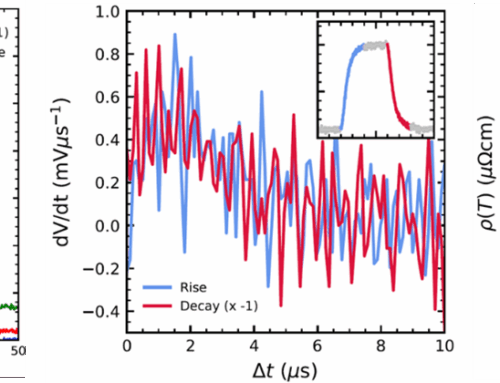Sandra Kleuskens, HFML Nijmegen and IMM Radboud, Daniela Wilson, IMM Radboud, and Hans Engelkamp, HFML Nijmegen.
Researchers of HFML-FELIX and the Radboud University have determined the magnetic anisotropy of polystyrene in poly-ethyleneglycol polystyrene polymersomes by magnetic birefringence and transmission electron microscopy. The magnetic anisotropy found is only a small fraction of what is theoretically predicted due to random coiling. Ordening polymers in the polymersome membrane can be essential to reduce the necessary magnetic field for applications. Using the diamagnetic anisotropy of polymers for the characterization of polymers and their aggregates is a comparatively new approach in the field of soft-matter and polymer research. For crystals and individual molecules, obtaining the diamagnetic anisotropy is often relatively straightforward, either through experimental methods or computational calculations. However, a good and thorough quantitative description of the diamagnetic properties of polymer aggregates has been lacking due to their random nature. Using a simple equation, that links the magnetic properties of an average polymer-repeating unit to that of the polymer vesicle of any shape (disc, tube, rod, stomatocyte), we measured, using magnetic birefringence, the average diamagnetic anisotropy of a polystyrene (PS) repeating unit inside a poly(ethylene glycol)polystyrene polymersome membrane as a function of the PS length and as function of the preparation method. All obtained values have a negative sign, which results into polymers tending to align perpendicularly to an applied magnetic field. The team found very similar anisotropies for all polymersome shapes, which shows that the individual polymers are organized very similar in each case. Moreover, the value found is only a fraction (~1 %) of what it could maximally be if the polymers were fully organized. Yet, it is sufficient to be useful in aligning and deforming various shapes of polymersomes, albeit at rather high fields. We, therefore, predict that further ordering of the polymers within the membrane will lead to similar responses at much lower magnetic fields, possibly obtainable with permanent magnets, which would be highly advantageous for practical applications.

Figure: (a) Schematic images of an ellipsoid, a tube, a disc, and a stomatocyte. The distributions of the individual polymers are indicated at several positions. The ellipsoid, tube, and stomatocyte have most polymers perpendicular to the vesicles’ symmetry axis (dashed arrow), while the disc has most polymers parallel to its symmetry axis. Therefore, a disc and an ellipsoid, a tube or a stomatocyte will align with their symmetry axis in opposite directions. The two possibilities are shown in (b). (c) Legend also shows how the magnetic anisotropy of polystyrene (PS) is defined with respect to the polymer.
The Average Magnetic Anisotropy of Polystyrene in Polymersomes Self-Assembled from Poly(Ethylene Glycol)-b-Polystyrene, R. S. M. Rikken, S. Kleuskens, L. K. E. A. Abdelmohsen, H. Engelkamp, R. J. M. Nolte, J. C. Maan, J. C. M. van Hest, D. A. Wilson, and P. C. M. Christianen, Soft Matter 20, 730 (2024).
https://pubs.rsc.org/en/content/articlelanding/2023/sm/d3sm01333b
Contact: http://hans.engelkamp@ru.n






